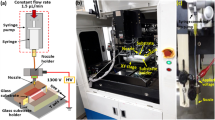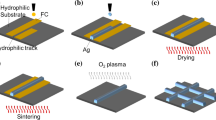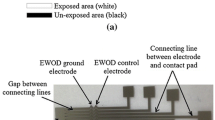Abstract
Due to the expensive price of the fabrication process of the existing semiconductor technology, printing technology has become the center of much attention in research as a micro fabrication technology. Among printing technologies, the rReverse-offset-printing (ROP) method that can achieve high resolution and complicated shape patterns is utilized to fabricate the electrowetting-on-dielectric (EWOD) device, which has been widely researched for the control small-scale droplets. The EWOD device consists of three-layers which were successfully fabricated by the solution-based process. As a metal layer, Ag-ink was printed on the glass substrate by the ROP method. On top of this layer, a polymer solution (polyvinylphenol, PVP) was spin-coated as a dielectric layer, which has a high dielectric strength (100 V/mm) and high dielectric constant (3.9) compared to other spin-coatable dielectric materials. The Teflon solution was spin-coated on top of the dielectric layer to deposit a hydrophobic surface. Using the printed EWOD device, the transport of micro-size droplets was successfully demonstrated.
Similar content being viewed by others
References
Kang, K. H., “How Electrostatic Fields Change Contact Angle in Electrowetting,” Langmuir, Vol. 18, No. 26, pp. 10318–10322, 2002.
Mugele, F. and Baret, J. C., “Electrowetting: From Basics to Applications,” Journal of Physics: Condensed Matter, Vol. 17, No. 28, p. R705, 2005.
Kuiper, S. and Hendriks, B., “Variable-Focus Liquid Lens for Miniature Cameras,” Applied Physics Letters, Vol. 85, No. 7, pp. 1128–1130, 2004.
Smith, N. R., Abeysinghe, D. C., Haus, J. W., and Heikenfeld, J., “Agile Wide-Angle Beam Steering with Electrowetting Microprisms,” Optics Express, Vol. 14, No. 14, pp. 6557–6563, 2006.
Hayes, R. A. and Feenstra, B. J., “Video-Speed Electronic Paper based on Electrowetting,” Nature, Vol. 425, No. 6956, pp. 383–385, 2003.
Cho, S. K., Moon, H., and Kim, C. J., “Creating, Transporting, Cutting, and Merging Liquid Droplets by Electrowetting-based Actuation for Digital Microfluidic Circuits,” Microelectromechanical Systems, Journal of, Vol. 12, No. 1, pp. 70–80, 2003.
Boeuf, J., “Plasma Display Panels: Physics, Recent Developments and Key Issues,” Journal of Physics D: Applied Physics, Vol. 36, No. 6, p. R53, 2003.
Menard, E., Meitl, M. A., Sun, Y., Park, J. U., Shir, D. J. L., et al., “Micro-and Nanopatterning Techniques for Organic Electronic and Optoelectronic Systems,” Chemical Reviews, Vol. 107, No. 4, pp. 1117–1160, 2007.
Krebs, F. C., Gevorgyan, S. A., and Alstrup, J., “A Roll-to-Roll Process to Flexible Polymer Solar Cells: Model Studies, Manufacture and Operational Stability Studies,” Journal of Materials Chemistry, Vol. 19, No. 30, pp. 5442–5451, 2009.
Yu, J. S., Kim, I., Kim, J. S., Jo, J., Larsen-Olsen, T. T., et al., “Silver Front Electrode Grids for Ito-Free all Printed Polymer Solar Cells with Embedded and Raised Topographies, Prepared by Thermal Imprint, Flexographic and Inkjet Roll-to-Roll Processes,” Nanoscale, Vol. 4, No. 19, pp. 6032–6040, 2012.
Yang, L., Rida, A., Vyas, R., and Tentzeris, M. M., “RFID Tag and RF Structures on a Paper Substrate using Inkjet-Printing Technology,” IEEE Transactions on Microwave Theory and Techniques, Vol. 55, No. 12, pp. 2894–2901, 2007.
Zhao, X., Chu, B. T., Ballesteros, B., Wang, W., Johnston, C., et al., “Spray Deposition of Steam Treated and Functionalized Single-Walled and Multi-Walled Carbon Nanotube Films for Supercapacitors,” Nanotechnology, Vol. 20, No. 6, Paper No. 065605, 2009.
Kim, M., Koo, J. B., Baeg, K. J., Jung, S. W., Ju, B. K., and You, I. K., “Top-Gate Staggered Poly (3,3-Dialkyl-Quarterthiophene) Organic Thin-Film Transistors with Reverse-Offset-Printed Silver Source/Drain Electrodes,” Applied Physics Letters, Vol. 101, No. 13, Paper No. 133306, 2012.
Liu, H., Dharmatilleke, S., Maurya, D. K., and Tay, A. A., “Dielectric Materials for Electrowetting-on-Dielectric Actuation,” Microsystem Technologies, Vol. 16, No. 3, pp. 449–460, 2010.
Yi, U. C. and Kim, C. J., “Characterization of Electrowetting Actuation on Addressable Single-Side Coplanar Electrodes,” Journal of Micromechanics and Microengineering, Vol. 16, No. 10, pp. 2053–2059, 2006.
Pollack, M. G., Fair, R. B., and Shenderov, A. D., “Electrowettingbased Actuation of Liquid Droplets for Microfluidic Applications,” Applied Physics Letters, Vol. 77, No. 11, pp. 1725–1726, 2000.
Jang, Y., Lee, W. H., Park, Y. D., Kwak, D., Cho, J. H., and Cho, K., “High Field-Effect Mobility Pentacene Thin-Film Transistors with Nanoparticle Polymer Composite/Polymer Bilayer Insulators,” Applied Physics Letters, Vol. 94, No. 18, Paper No. 183301, 2009.
Klauk, H., Halik, M., Zschieschang, U., Schmid, G., Radlik, W., and Weber, W., “High-Mobility Polymer Gate Dielectric Pentacene Thin Film Transistors,” Journal of Applied Physics, Vol. 92, No. 9, pp. 5259–5263, 2002.
Abdelgawad, M. and Wheeler, A. R., “Rapid Prototyping in Copper Substrates for Digital Microfluidics,” Advanced Materials, Vol. 19, No. 1, pp. 133–137, 2007.
Kim, I., Kwak, S. W., Kim, K. S., Lee, T. M., Jo, J., et al., “Effect of Ink Cohesive Force on Gravure Offset Printing,” Microelectronic Engineering, Vol. 98, pp. 587–589, 2012.
Gupta, R., Sheth, D. M., Boone, T. K., Sevilla, A. B., and Fréchette, J., “Impact of Pinning of the Triple Contact Line on Electrowetting Performance,” Langmuir, Vol. 27, No. 24, pp. 14923–14929, 2011.
Li, F. and Mugele, F., “How to Make Sticky Surfaces Slippery: Contact Angle Hysteresis in Electrowetting with Alternating Voltage,” Applied Physics Letters, Vol. 92, No. 24, pp. 244108, 2008.
Nelson, W. C., Sen, P., and Kim, C. J. C., “Dynamic Contact Angles and Hysteresis under Electrowetting-on-Dielectric,” Langmuir, Vol. 27, No. 16, pp. 10319–10326, 2011.
Park, J. K., Lee, S. J., and Kang, K. H., “Fast and Reliable Droplet Transport on Single-Plate Electrowetting on Dielectrics using Nonfloating Switching Method,” Biomicrofluidics, Vol. 4, No. 2, Paper No. 024102, 2010.
Author information
Authors and Affiliations
Corresponding author
Rights and permissions
About this article
Cite this article
Kim, B., Lee, S.J., Kim, I. et al. Design and fabrication of printed electrowetting-on-dielectric device. Int. J. Precis. Eng. Manuf. 16, 989–995 (2015). https://doi.org/10.1007/s12541-015-0128-8
Received:
Revised:
Accepted:
Published:
Issue Date:
DOI: https://doi.org/10.1007/s12541-015-0128-8




